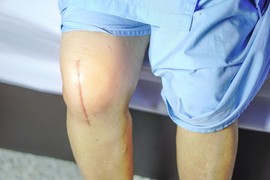The incidence of joint replacement procedures in the United States is high, with over 1 million total knee and hip replacement procedures being performed each year. This number is expected to rise dramatically over the coming years with the aging population due to a higher rate of diagnosis and treatment of arthritis, as well as a growing demand for improved mobility and quality of life.
 If your knee or hip joint has been severely damaged by arthritis (osteoarthritis or rheumatoid arthritis) or by an injury, simple everyday tasks such as walking, climbing stairs, and getting into and out of your car may be difficult due to severe pain, inflammation, and stiffness. At times, you may experience pain when lying or sitting down, and may even have a noticeable deformity of the joint. Conservative care is always the first approach for pain relief and maximizing function in a damaged joint. If medications and conservative treatment options, such as physical therapy, have reached their maximum benefit, your healthcare practitioner may recommend a joint replacement. While you are awaiting your joint replacement surgery it is recommended that you continue with your physical therapy program including cardiovascular conditioning, strength, postural, proprioception and balance training to shorten your recovery time.
If your knee or hip joint has been severely damaged by arthritis (osteoarthritis or rheumatoid arthritis) or by an injury, simple everyday tasks such as walking, climbing stairs, and getting into and out of your car may be difficult due to severe pain, inflammation, and stiffness. At times, you may experience pain when lying or sitting down, and may even have a noticeable deformity of the joint. Conservative care is always the first approach for pain relief and maximizing function in a damaged joint. If medications and conservative treatment options, such as physical therapy, have reached their maximum benefit, your healthcare practitioner may recommend a joint replacement. While you are awaiting your joint replacement surgery it is recommended that you continue with your physical therapy program including cardiovascular conditioning, strength, postural, proprioception and balance training to shorten your recovery time.
A total knee replacement surgery takes about 1 to 2 hours. During the surgery, your surgeon removes cartilage and bone that is damaged and positions a new plastic or metal implant to help restore normal alignment and function of the knee joint. A total hip replacement surgery takes a few hours.
During the procedure, your surgeon removes cartilage and bone that is damaged and positions a ceramic, plastic, or a metal implant to help restore normal alignment and function of the hip joint.
Rehabilitation typically begins the day of, or the day after, surgery. A physical therapist will work with you to teach you exercises that restore normal joint range of motion from your spine to your foot, and strengthen the muscles surrounding those joints. Just as before your surgery, posture restoration, balance training and cardiovascular conditioning will be vital components of a successful recovery. Pain and joint limitation will change the way you walk, so learning to walk properly again after the joint is replaced will ensure the new joint has even wear and proper loading to prolong its life.
There are a variety of ways that you can improve the life expectancy of your knee or hip implant including:
- Follow your rehabilitation regime through to the end - even a residual 10-15% loss of range or motion or strength at one of your leg joints will affect how you move, load and walk.
- Possibly leading to new compensation or further wear and tear on other joints.
- Regularly engaging in light exercise to maintain joint range of motion and strength- Taking precautions to avoid slips and falls and other injuries (i.e. use of assistive devices, shower chairs and bars, etc.)
- Ensuring that your dentist is aware that you have a joint implant prior to any dental work to avoid mouth bacteria from entering the bloodstream during a procedure and causing an infection in the joint prosthesis
- Following up with your surgeon periodically for examination and x-rays, even if you are feeling well.
Joint replacement surgery is safe and effective in most cases, and helps to relieve pain and improve function of the affected joint. However, as with any surgical procedure, there are risks involved, including: infection, blood clots, problems with the implant, persistent pain, and neurovascular injury. Additionally, you need to keep in mind that in order to experience all of the benefits of a joint replacement, it’s important to follow through with the recommended course of physical therapy.
If you have undergone a knee or hip replacement you may benefit from physical therapy. Undergoing a comprehensive evaluation by physical therapists at Iron City Physical Therapy is one of the best ways to properly rehabilitate your body after a joint replacement. After the assessment, our physical therapists will create a program that is specific to your needs and set you on the right path toward optimal functioning of your replaced joint.
References
1. Maradit Kremers H, Larson D, Crowson C et al. Prevalence of Total Hip and Knee Replacement in the United States. The Journal of Bone and Joint Surgery-American Volume. 2015;97(17):1386-1397. doi:10.2106/jbjs.n.01141.
2. Gademan M, Hofstede S, Vliet Vlieland T, Nelissen R, Marang-van de Mheen P. Indication criteria for total hip or knee arthroplasty in osteoarthritis: a state-of-the-science overview. BMC Musculoskelet Disord. 2016;17(1). doi:10.1186/s12891-016-1325-z.
3. Total Knee Replacement - OrthoInfo - AAOS. Orthoinfoaaos.org. 2018. Available at: https://orthoinfo.aaos.org/en/treatment/total-knee-replacement/. Accessed May 10, 2018.
4. Total Hip Replacement - OrthoInfo - AAOS. Orthoinfoaaos.org. 2018. Available at: https://orthoinfo.aaos.org/en/treatment/total-hip-replacement/. Accessed May 10, 2018.




